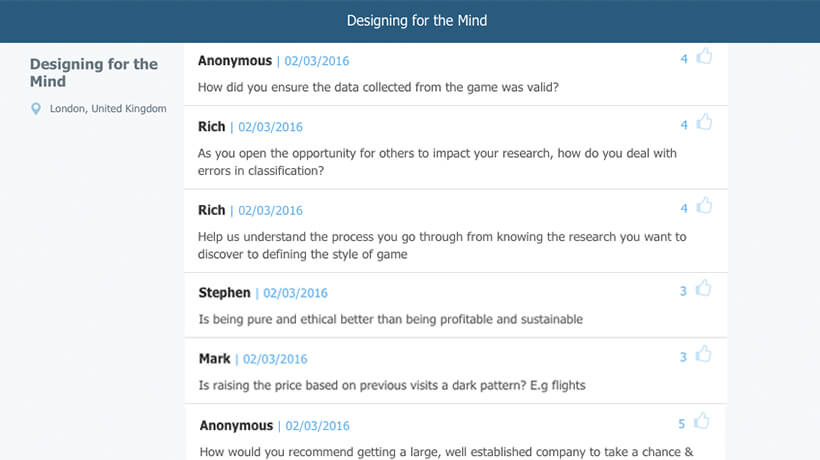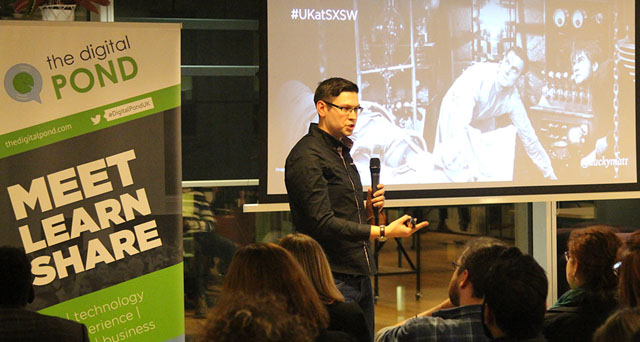We kicked off the first night of our popular event series for 2016 with a sneak peek at the innovation on offer at SXSW, the revered set of festivals in Austin. The Digital Pond featured stellar speakers from the UK, exploring how we can leverage psychology to engage our target audiences.
Last year, we were captivated by the future of the user experience (UX) field – touching on everything from trends to the evolution of designers’ roles. Kicking off The Digital Pond’s insights for 2016, we thought it best to set the stage. By understanding the factors that underpin an exceptional user experience, we can take advantage of the constantly changing digital environment; evaluating the new channels and techniques available to engage audiences, against our goals.
Geek Squad’s Founder Robert Stephens firmly believes “you cannot design a customer experience because it is whatever the customer perceives it to be.” His words raise the question: if the unique experience of a person can’t be completely controlled, what are some of the ways we can influence it?
As we pondered the best of the best to bring along, we were swept up in the feverish anticipation of the annual SXSW festival season. With two of our own flying off to Texas, we thought – what’s better than bringing the festivities straight to the heart of London?
This Digital Pond aimed to delve deeper into different ways of encouraging your target audience to interact with your brand and business, time and time again. Our Matt Gibson (CCO), Cristina Viganò (Designer) and alumni, Neil Dawson (UX Architect, now at AnalogFolk) were joined by Eamonn Carey (former Co-Founder of FarmVillain) and Leslie Harris (Project Manager at Citizen Science, Cancer Research UK) to share expert insights.
Have a look at our highlights below – and I’ll share a few fascinating ideas from each session.
Take a glimpse of our events highlights from the evening.
Harnessing the Power of the Crowd
Tapping into the human psyche, Leslie Harris from Cancer Research UK explored the power of play to beat cancer sooner. She took us through the success of the renowned charity in harnessing the combined power of crowd sourcing and the consumer’s passion for gaming – it turns out that each of us can support vital cancer research!
The oncology field generates extensive amounts of data, and much of the analysis must be done manually. Our human brain is fantastic at pattern recognition; we can make complex inferences across assorted images, which algorithms aren’t as capable of. To accelerate research, Leslie and her team have released a total of 5 games to date – here’s a peek at one of them:
PLAY TO CURE: GENES IN SPACE
This was the world’s first mobile game dedicated to analysing cancer data: it achieved over 400,000 downloads and enabled 1980 patients’ genome sets to each be analysed over 50 times. The user’s mission is to collect substances called “Element Alpha,” which represent genetic breast cancer data, by mapping their route in space. Points can also be earned by shooting asteroids and subsequently upgrade your ship.
More Than Media Queries: Reframing Responsive UX
Responsive design is often framed as an implementation challenge. We constantly focus on making our designs squeeze into screens of all shapes and sizes. However, Matt explored responsive design from a user experience perspective, looking at how we can make effective and usable designs beyond implementing media queries to make them stretchy.
Far too many designers equate mobile with “on-the-go.” But with over 39% of people using their mobile in the loo, we just can’t assume where, when and how users are access our content. Matt offered up a series of tips to create performance-led designs, devise mobile-first content strategies and build more future-friendly designs through progressive enhancement. Rather than starting with a bloated desktop website and then scaling down for smaller screens, it’s more effective to start with the constraints of a small device and then scale upwards. You can find out more about his tips by reading his slides below:
More than Media Queries: Reframing Responsive UX - SXSW 2016 from Matt Gibson
WE NEED MORE MISCHIEF AND WHIMSY
Injecting humour and mischief into your products and communications is a sure-fire way to grab more attention. Eamonn reminded us about the importance of making our audiences laugh and smile – it’s different from being bombarded with adverts from faceless corporations. Happiness triggers dopamine, which then improves your memory, making these moments with your brand memorable. Even for organisations that have a more serious or professional tone, baking fun and playfulness into your brand can have a lasting impact.
Rewinding back to 2009, if you were an avid user of Facebook you can’t have missed the FarmVille game. Swamped with notifications from players (there were over 80 million users then!) Eamonn channelled his frustrations into a satirical parody of the game. In the FarmVillain spoof, players could prank or sabotage other user’s farms by burning their barns or bestowing mad cow disease. The game achieved over a million active monthly users before it was sold to Gamestop.
Mischief and Whimsy in products and apps from Eamonn Carey
Dark Times for Dark Patterns: Ethical Alternatives
Using ‘dark patterns’ in designs can be tempting. These compel people to do things they normally wouldn’t – a quick shortcut to results, but taking advantage of quirks of the human brain. Unethically deceiving users isn’t conducive to a good night’s sleep; these techniques can even result in hefty fines and loss of customer trust.
Neil and Cristina explored how we can spot common dark patterns, and judge whether they’re deliberate. The whimsical adage of Hanlon’s Razor helps: ‘never attribute to malice that which can be adequately explained by stupidity’. Dark patterns caused by thoughtlessness are coined as “anti-patterns,” and should be highlighted, understood and corrected; preventing detrimental damage to brands.
From here, they revealed how to meet our goals through ethical encouragement of users: combining psychological principles and persuasive design techniques. Increasing the urgency of purchase through sales is a classic example; another would be ‘anchoring’, or suggesting complimentary products to users just as they’ve committed to purchase. Their slides below will walk you through more ideas:
Dark Times for Dark Patterns from Cristina Viganò
The Big Applause
With support from all our speakers, sponsors and organisers, we kicked off the year with a blast. Our audience soaked up plenty of digital inspiration, continuing to network well into the night: indulging in free drinks, food and great company. Plenty of thought-provoking questions followed each talk, and speakers were keen to oblige with new ideas:

The speakers answered all of the audiences' pressing questions, which were crowdsourced during each keynote.
Once again, thanks to WeWork Aldgate Tower, Balsamiq and CitizenSafe for partnering with us and making this event a great success.
Keep an eye out for future events by following us on Twitter or joining our Meetup group – we’d love to meet you! If you’d like to get involved as a sponsor for any future events, please contact us to find out more.


